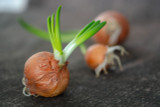5 Fastest Growing Vegetables You Can Harvest In Under Two Months
Throughout summer, as you harvest your vegetables from your garden, you'll likely start noticing those inevitable gaps. You'll attract weeds if you leave them as nothing more than bare ground. What’s more, during summer storms, they’re an open invitation for erosion.
Rather than leaving gaps, consider planting some of the fastest growing vegetables available. With long summer days and plenty of heat still in store, from sowing to harvest time, certain vegetables require very little time.
The vegetables shown below need just a few short weeks of growing time before you harvest them.
Radishes
You'll only need to wait about 25 days from sowing to harvest time if you plant radishes. What's more, they are one of the easier vegetables to grow. About 1 inch apart, space the plump seeds very thinly. Use potting soil or prepared ground. Every few weeks, sow small batches to keep them coming until the end of the season.
Carrots
Roughly 50 days will be needed from planting the seeds to harvest time for carrots. In just six weeks, you can expect crunchy, sweet carrots if you choose a quick-growing variety that is finger sized. Thinly spread the seeds over the surface in containers of potting soil. Then, use a little more potting soil to make a thin sieved covering layer.
If planting directly into the ground, you can put the seeds into 6-inch spaced drills, cover them, and water them.
Bush Beans
In about 60 days, you can harvest bush beans after planting. Right after you remove a different crop, you can immediately sow the seeds for these speedy vegetables. Kids love these beans, and they’re trouble-free.
Use pots of potting soil or plant them directly into the ground. Space them 10 to 16 inches apart and poke the seeds right into the soil. Until the end of summer, you can sow a batch once a month. The bushy, short plants will soon flower.
Every few days, pick the pods as they appear. You'll encourage new forming pods if you pick them regularly.
Salad Leaves
You have vegetables, so you might as well make a salad. In about 21 days, you'll be able to harvest your salad leaves after planting. In fact, you can make more than just salads with salad leaves. They grow in several varieties and you can even make your own variety by mixing two or more seeds together.
Into 6-to-10-inch spaced drills, sow the seeds very thinly. After covering the seeds, gently pat down the soil on the surface. Along the rows, apply water, and keep them moist. As the seedlings grow, make sure they are weed-free. To reduce temperatures for good growth and germination, if your area is particularly hot, you may decide to use a shade cloth for protection.
Spinach
Spinach is nice as an addition, used alone as a salad, or cooked. The succulent, smooth leaves’ versatility is extraordinary. They also go well in pasta dishes, quiches, and more. Right up until the first frost, you could keep on enjoying spinach if you plant once a month.
In rows about a foot apart, sow the seeds into the soil. The resulting seedlings can be thinned to roughly 8 inches apart. Leaves may turn bitter in hot weather because they tend to "bolt". In the hottest part of summer, sowing your seeds in light shade will help prevent this, as well as making sure the ground is kept moist.
Ready to Plant Some Fast-Growing Vegetables?
Whether you're planting fast-growing vegetables, a flower garden, or vegetables at the very beginning of the season, we have the seeds you need at Freedom Farms. From gardening gloves to pots and other accessories, we've got you covered.
To contact us, please use our convenient online form.
Recent Posts
-
The Secrets To Growing Radishes In Containers
Container gardening is a popular way to grow vegetables like radishes. Growing radishes in container …26th Jun 2023 -
How To Successfully Grow Onions From Seeds
Many recipes use onions to give a strong taste and smell. Growing onions from seeds is better than b …26th Jun 2023 -
How To Grow Radishes At Home: A Step-By-Step Guide
Growing your radishes at home can be a rewarding and delicious endeavor. These crispy and spicy vegg …26th Jun 2023




